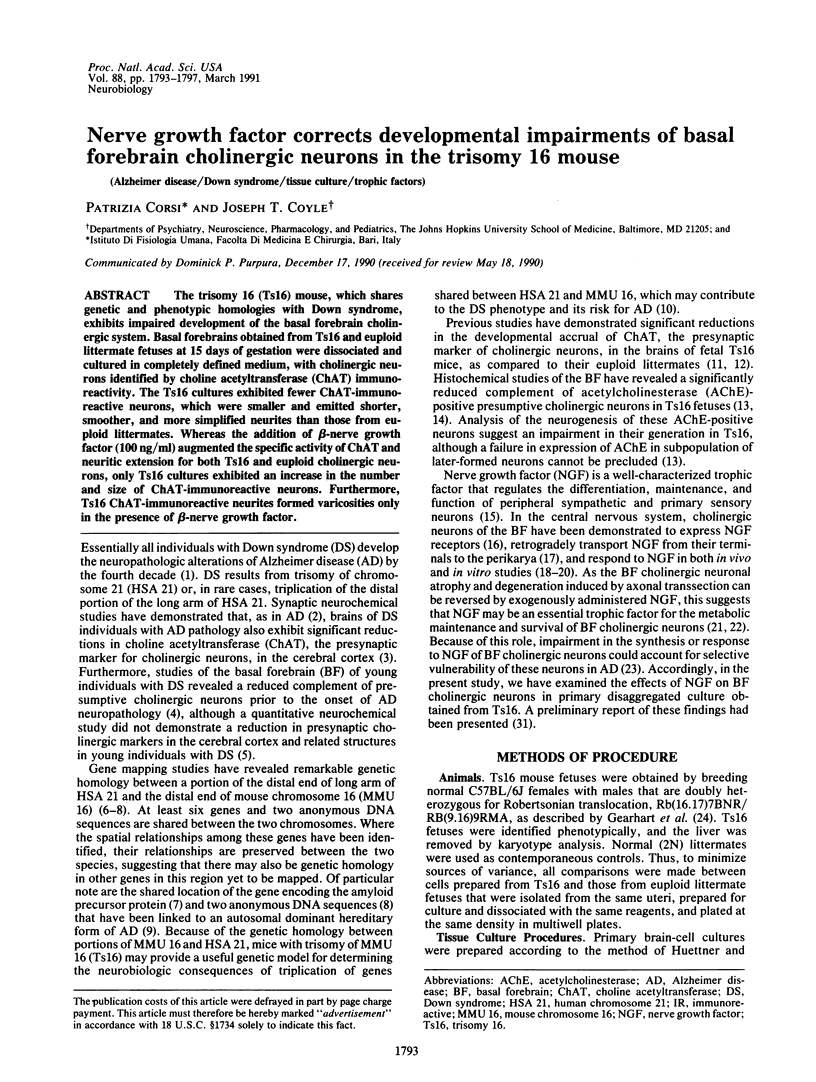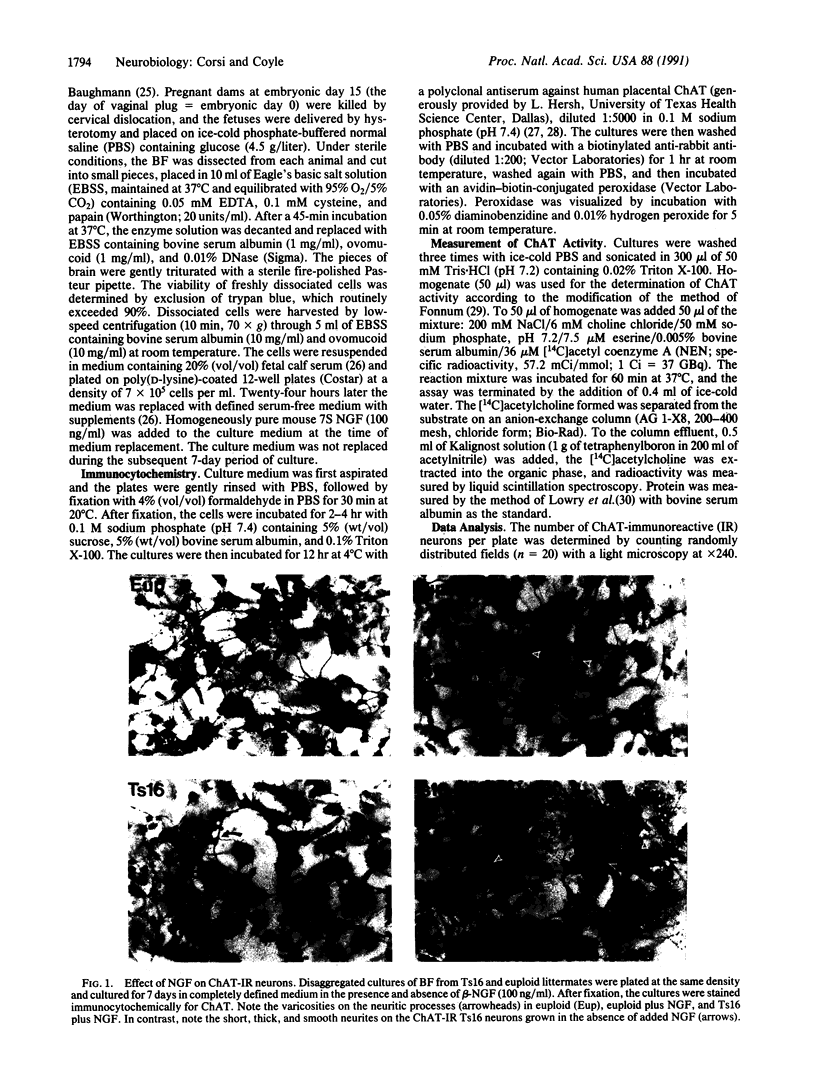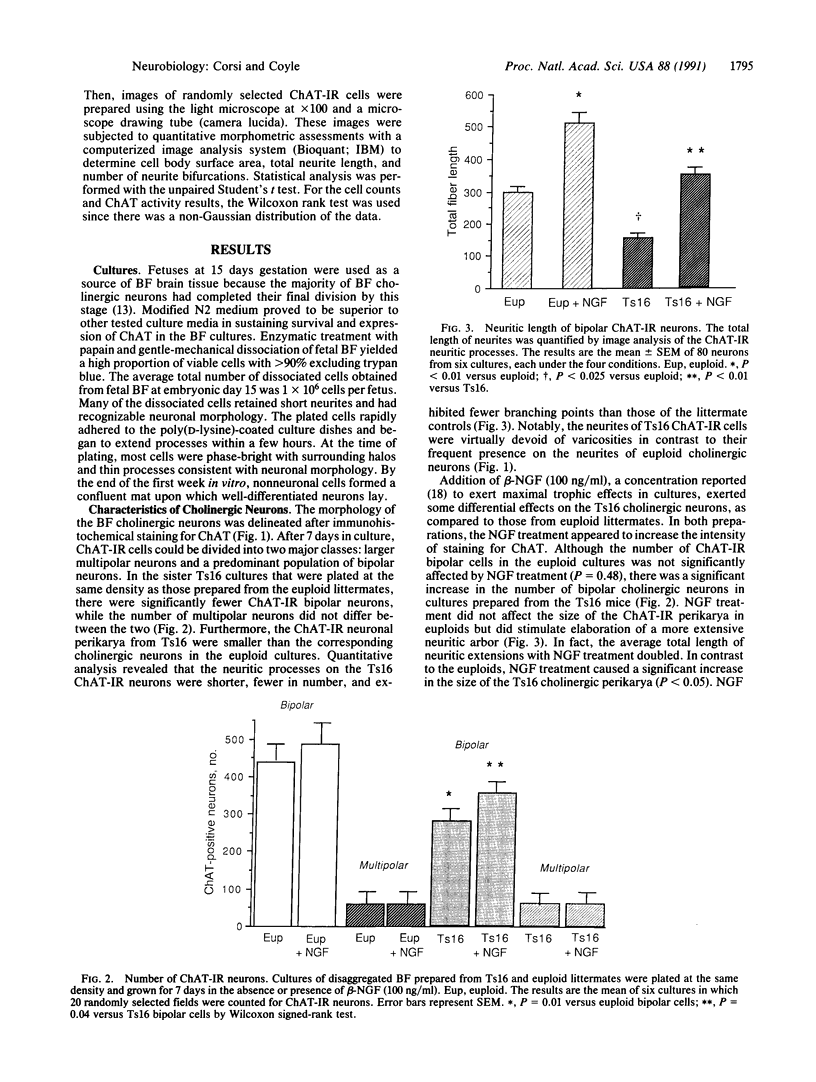Abstract
The trisomy 16 (Ts16) mouse, which shares genetic and phenotypic homologies with Down syndrome, exhibits impaired development of the basal forebrain cholinergic system. Basal forebrains obtained from Ts16 and euploid littermate fetuses at 15 days of gestation were dissociated and cultured in completely defined medium, with cholinergic neurons identified by choline acetyltransferase (ChAT) immunoreactivity. The Ts16 cultures exhibited fewer ChAT-immunoreactive neurons, which were smaller and emitted shorter, smoother, and more simplified neurites than those from euploid littermates. Whereas the addition of beta-nerve growth factor (100 ng/ml) augmented the specific activity of ChAT and neuritic extension for both Ts16 and euploid cholinergic neurons, only Ts16 cultures exhibited an increase in the number and size of ChAT-immunoreactive neurons. Furthermore, Ts16 ChAT-immunoreactive neurites formed varicosities only in the presence of beta-nerve growth factor.
Full text
PDF




Images in this article
Selected References
These references are in PubMed. This may not be the complete list of references from this article.
- Bottenstein J. E., Sato G. H. Growth of a rat neuroblastoma cell line in serum-free supplemented medium. Proc Natl Acad Sci U S A. 1979 Jan;76(1):514–517. doi: 10.1073/pnas.76.1.514. [DOI] [PMC free article] [PubMed] [Google Scholar]
- Bruce G., Wainer B. H., Hersh L. B. Immunoaffinity purification of human choline acetyltransferase: comparison of the brain and placental enzymes. J Neurochem. 1985 Aug;45(2):611–620. doi: 10.1111/j.1471-4159.1985.tb04030.x. [DOI] [PubMed] [Google Scholar]
- Buck C. R., Martinez H. J., Black I. B., Chao M. V. Developmentally regulated expression of the nerve growth factor receptor gene in the periphery and brain. Proc Natl Acad Sci U S A. 1987 May;84(9):3060–3063. doi: 10.1073/pnas.84.9.3060. [DOI] [PMC free article] [PubMed] [Google Scholar]
- Casanova M. F., Walker L. C., Whitehouse P. J., Price D. L. Abnormalities of the nucleus basalis in Down's syndrome. Ann Neurol. 1985 Sep;18(3):310–313. doi: 10.1002/ana.410180306. [DOI] [PubMed] [Google Scholar]
- Cheng S. V., Nadeau J. H., Tanzi R. E., Watkins P. C., Jagadesh J., Taylor B. A., Haines J. L., Sacchi N., Gusella J. F. Comparative mapping of DNA markers from the familial Alzheimer disease and Down syndrome regions of human chromosome 21 to mouse chromosomes 16 and 17. Proc Natl Acad Sci U S A. 1988 Aug;85(16):6032–6036. doi: 10.1073/pnas.85.16.6032. [DOI] [PMC free article] [PubMed] [Google Scholar]
- Cox D. R., Epstein C. J. Comparative gene mapping of human chromosome 21 and mouse chromosome 16. Ann N Y Acad Sci. 1985;450:169–177. doi: 10.1111/j.1749-6632.1985.tb21491.x. [DOI] [PubMed] [Google Scholar]
- Coyle J. T., Oster-Granite M. L., Gearhart J. D. The neurobiologic consequences of Down syndrome. Brain Res Bull. 1986 Jun;16(6):773–787. doi: 10.1016/0361-9230(86)90074-2. [DOI] [PubMed] [Google Scholar]
- Coyle J. T., Oster-Granite M. L., Reeves R., Hohmann C., Corsi P., Gearhart J. Down syndrome and the trisomy 16 mouse: impact of gene imbalance on brain development and aging. Res Publ Assoc Res Nerv Ment Dis. 1991;69:85–99. [PubMed] [Google Scholar]
- Coyle J. T., Price D. L., DeLong M. R. Alzheimer's disease: a disorder of cortical cholinergic innervation. Science. 1983 Mar 11;219(4589):1184–1190. doi: 10.1126/science.6338589. [DOI] [PubMed] [Google Scholar]
- Fischer W., Wictorin K., Björklund A., Williams L. R., Varon S., Gage F. H. Amelioration of cholinergic neuron atrophy and spatial memory impairment in aged rats by nerve growth factor. Nature. 1987 Sep 3;329(6134):65–68. doi: 10.1038/329065a0. [DOI] [PubMed] [Google Scholar]
- Fonnum F. A rapid radiochemical method for the determination of choline acetyltransferase. J Neurochem. 1975 Feb;24(2):407–409. doi: 10.1111/j.1471-4159.1975.tb11895.x. [DOI] [PubMed] [Google Scholar]
- Gearhart J. D., Davisson M. T., Oster-Granite M. L. Autosomal aneuploidy in mice: generation and developmental consequences. Brain Res Bull. 1986 Jun;16(6):789–801. doi: 10.1016/0361-9230(86)90075-4. [DOI] [PubMed] [Google Scholar]
- German D. C., Bruce G., Hersh L. B. Immunohistochemical staining of cholinergic neurons in the human brain using a polyclonal antibody to human choline acetyltransferase. Neurosci Lett. 1985 Oct 24;61(1-2):1–5. doi: 10.1016/0304-3940(85)90391-x. [DOI] [PubMed] [Google Scholar]
- Hatanaka H., Tsukui H., Nihonmatsu I. Developmental change in the nerve growth factor action from induction of choline acetyltransferase to promotion of cell survival in cultured basal forebrain cholinergic neurons from postnatal rats. Brain Res. 1988 Mar 1;467(1):85–95. doi: 10.1016/0165-3806(88)90069-7. [DOI] [PubMed] [Google Scholar]
- Hefti F., Hartikka J., Eckenstein F., Gnahn H., Heumann R., Schwab M. Nerve growth factor increases choline acetyltransferase but not survival or fiber outgrowth of cultured fetal septal cholinergic neurons. Neuroscience. 1985 Jan;14(1):55–68. doi: 10.1016/0306-4522(85)90163-0. [DOI] [PubMed] [Google Scholar]
- Hefti F. Nerve growth factor promotes survival of septal cholinergic neurons after fimbrial transections. J Neurosci. 1986 Aug;6(8):2155–2162. doi: 10.1523/JNEUROSCI.06-08-02155.1986. [DOI] [PMC free article] [PubMed] [Google Scholar]
- Huettner J. E., Baughman R. W. Primary culture of identified neurons from the visual cortex of postnatal rats. J Neurosci. 1986 Oct;6(10):3044–3060. doi: 10.1523/JNEUROSCI.06-10-03044.1986. [DOI] [PMC free article] [PubMed] [Google Scholar]
- Kish S., Karlinsky H., Becker L., Gilbert J., Rebbetoy M., Chang L. J., DiStefano L., Hornykiewicz O. Down's syndrome individuals begin life with normal levels of brain cholinergic markers. J Neurochem. 1989 Apr;52(4):1183–1187. doi: 10.1111/j.1471-4159.1989.tb01864.x. [DOI] [PubMed] [Google Scholar]
- Kiss J., Schlumpf M., Balázs R. Selective retardation of the development of the basal forebrain cholinergic and pontine catecholaminergic nuclei in the brain of trisomy 16 mouse, an animal model of Down's syndrome. Brain Res Dev Brain Res. 1989 Dec 1;50(2):251–264. doi: 10.1016/0165-3806(89)90201-0. [DOI] [PubMed] [Google Scholar]
- Kromer L. F. Nerve growth factor treatment after brain injury prevents neuronal death. Science. 1987 Jan 9;235(4785):214–216. doi: 10.1126/science.3798108. [DOI] [PubMed] [Google Scholar]
- LOWRY O. H., ROSEBROUGH N. J., FARR A. L., RANDALL R. J. Protein measurement with the Folin phenol reagent. J Biol Chem. 1951 Nov;193(1):265–275. [PubMed] [Google Scholar]
- Levi-Montalcini R. The nerve growth factor: thirty-five years later. EMBO J. 1987 May;6(5):1145–1154. doi: 10.1002/j.1460-2075.1987.tb02347.x. [DOI] [PMC free article] [PubMed] [Google Scholar]
- Mobley W. C., Rutkowski J. L., Tennekoon G. I., Gemski J., Buchanan K., Johnston M. V. Nerve growth factor increases choline acetyltransferase activity in developing basal forebrain neurons. Brain Res. 1986 Jul;387(1):53–62. doi: 10.1016/0169-328x(86)90020-3. [DOI] [PubMed] [Google Scholar]
- Ozand P. T., Hawkins R. L., Collins R. M., Jr, Reed W. D., Baab P. J., Oster-Granite M. L. Neurochemical changes in murine trisomy 16: delay in cholinergic and catecholaminergic systems. J Neurochem. 1984 Aug;43(2):401–408. doi: 10.1111/j.1471-4159.1984.tb00915.x. [DOI] [PubMed] [Google Scholar]
- Reeves R. H., Gearhart J. D., Littlefield J. W. Genetic basis for a mouse model of Down syndrome. Brain Res Bull. 1986 Jun;16(6):803–814. doi: 10.1016/0361-9230(86)90076-6. [DOI] [PubMed] [Google Scholar]
- Reeves R. H., Robakis N. K., Oster-Granite M. L., Wisniewski H. M., Coyle J. T., Gearhart J. D. Genetic linkage in the mouse of genes involved in Down syndrome and Alzheimer's disease in man. Brain Res. 1987 Sep;388(3):215–221. doi: 10.1016/0169-328x(87)90028-3. [DOI] [PubMed] [Google Scholar]
- Singer H. S., Tiemeyer M., Hedreen J. C., Gearhart J., Coyle J. T. Morphologic and neurochemical studies of embryonic brain development in murine trisomy 16. Brain Res. 1984 Aug;317(2):155–166. doi: 10.1016/0165-3806(84)90093-2. [DOI] [PubMed] [Google Scholar]
- Sweeney J. E., Höhmann C. F., Oster-Granite M. L., Coyle J. T. Neurogenesis of the basal forebrain in euploid and trisomy 16 mice: an animal model for developmental disorders in Down syndrome. Neuroscience. 1989;31(2):413–425. doi: 10.1016/0306-4522(89)90384-9. [DOI] [PubMed] [Google Scholar]
- Williams L. R., Varon S., Peterson G. M., Wictorin K., Fischer W., Bjorklund A., Gage F. H. Continuous infusion of nerve growth factor prevents basal forebrain neuronal death after fimbria fornix transection. Proc Natl Acad Sci U S A. 1986 Dec;83(23):9231–9235. doi: 10.1073/pnas.83.23.9231. [DOI] [PMC free article] [PubMed] [Google Scholar]
- Yates C. M., Simpson J., Gordon A., Maloney A. F., Allison Y., Ritchie I. M., Urquhart A. Catecholamines and cholinergic enzymes in pre-senile and senile Alzheimer-type dementia and Down's syndrome. Brain Res. 1983 Nov 28;280(1):119–126. doi: 10.1016/0006-8993(83)91179-4. [DOI] [PubMed] [Google Scholar]









